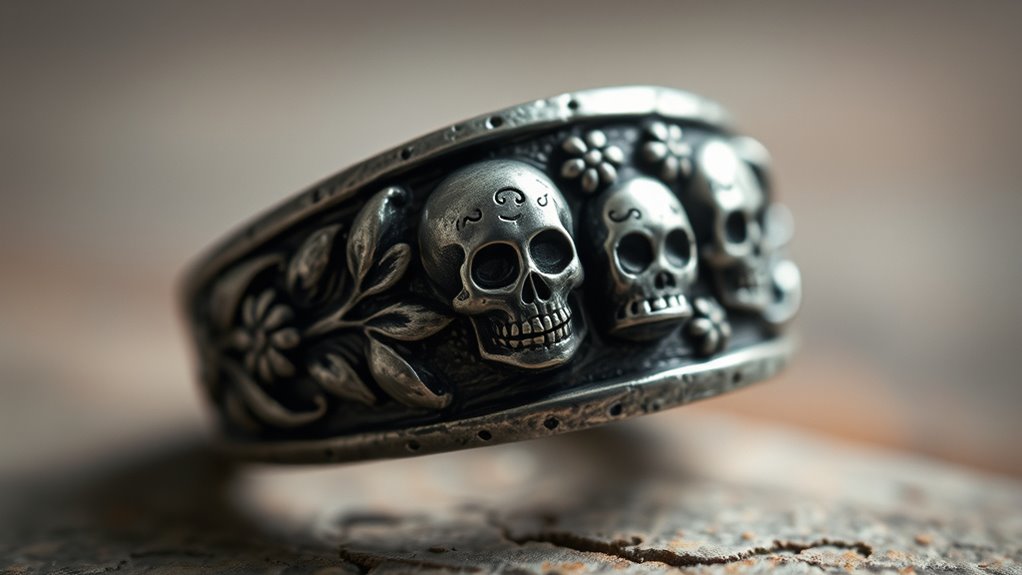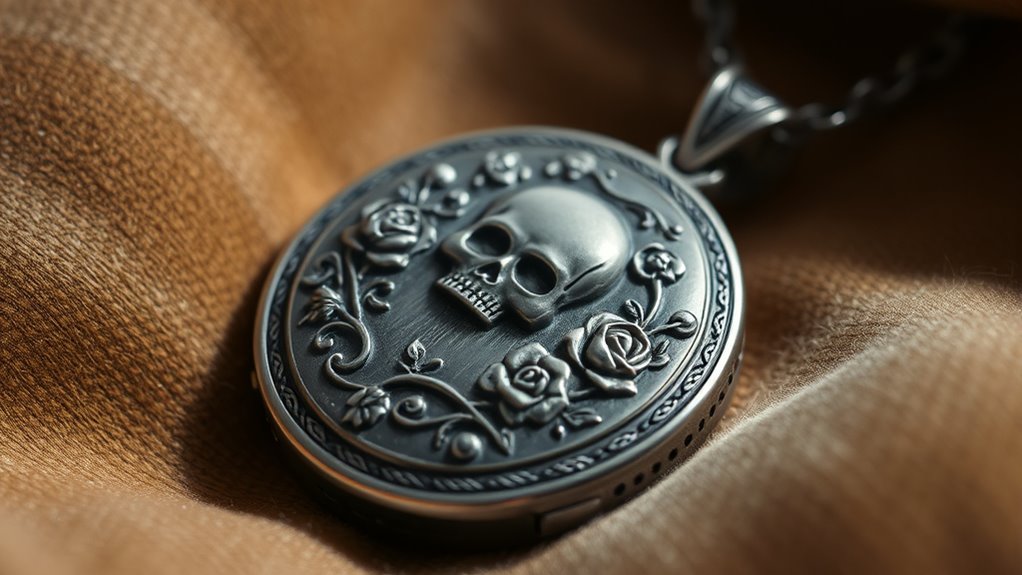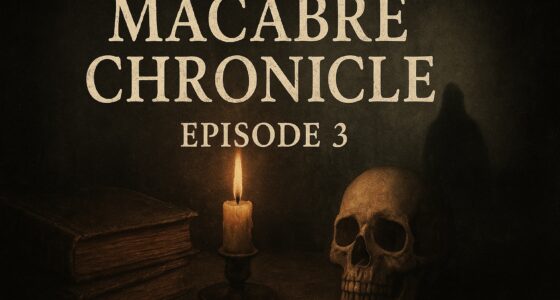Memento mori jewelry has origins that trace back to ancient Europe, especially during the Middle Ages and Renaissance, where it served as a reminder of life’s fleeting nature and mortality. Symbols like skulls, hourglasses, and skeletal motifs were common, encouraging reflection on mortality and living purposefully. Over time, these items evolved from funeral artifacts to personal accessories that promote mindfulness and humility. If you explore further, you’ll discover how these pieces carry deep cultural and philosophical meanings that still resonate today.
Key Takeaways
- Memento Mori jewelry originated in Europe during the Middle Ages and Renaissance as symbols of mortality and spiritual reflection.
- It features motifs like skulls, hourglasses, and skeletal imagery to remind wearers of life’s transient nature.
- The jewelry evolved from funeral artifacts into portable tokens, serving as personal reminders to live intentionally.
- These pieces often include Latin inscriptions and miniature skulls, emphasizing mindfulness and humility.
- Memento Mori jewelry reflects a long-standing cultural tradition of confronting mortality to inspire meaningful living.

Memento Mori jewelry serves as a powerful reminder of life’s fleeting nature, encouraging you to reflect on mortality and live intentionally. This type of jewelry is deeply rooted in funeral symbolism, historically created to remind wearers of the inevitability of death. Throughout history, funeral symbolism has played a vital role in shaping how societies confront mortality, and memento mori pieces act as wearable tokens of that tradition. These artifacts often feature skulls, hourglasses, or skeletal imagery—visual cues that prompt you to consider life’s transient nature. As historical artifacts, they carry centuries of meaning, serving both as personal reminders and as part of cultural rituals surrounding death and remembrance. Wearing memento mori jewelry isn’t just about aesthetics; it’s about embracing a philosophy that confronts mortality head-on. When you see a skull carved into a ring or a necklace adorned with a cadaverous motif, you’re reminded to cherish each moment and live with purpose. These symbols, once common in funeral art and tombstone carvings, have transitioned into jewelry that transcends mere decoration. They’re visual reminders that life is fragile and that death is an inevitable part of the human experience. By incorporating funeral symbolism into your daily life, you’re engaging with a tradition that has persisted for centuries, turning a simple accessory into a profound statement of awareness. Additionally, the cultural significance of these symbols varies across different societies, enriching their meaning and emphasizing universal themes of mortality. The historical significance of memento mori jewelry goes beyond its visual appeal. Many of these pieces originated in Europe during the Middle Ages and Renaissance periods, when death was a pervasive part of everyday life. Artifacts from this era often included symbols meant to remind the living of their mortality, encouraging reflection and spiritual preparedness. Over time, this concept evolved into jewelry that you can wear, making the message more personal and portable. Whether it’s a ring inscribed with Latin phrases or a locket containing a tiny skull, each piece carries a story rooted in history and tradition, connecting you to a long lineage of cultural attitudes toward death. Ultimately, memento mori jewelry invites you to embrace mortality as a natural part of life. It’s about transforming the fear of death into a motivation to live fully. When you wear these pieces, you’re not just making a fashion statement—you’re participating in a centuries-old tradition that encourages mindfulness, humility, and appreciation for each fleeting moment. This jewelry serves as an intimate, tangible reminder that life’s beauty is heightened by its impermanence, and that acknowledging death can inspire a more meaningful existence.
Frequently Asked Questions
When Did Memento Mori Jewelry Originate Historically?
You’ll find that memento mori jewelry originated in the late Middle Ages, around the 15th century, during a time when funeral customs emphasized remembrance of mortality. It served as a powerful reminder of life’s fleeting nature through historical symbolism like skulls and hourglasses. By wearing these pieces, you participate in a tradition that encourages reflection on mortality, blending art and memory to honor your loved ones and embrace life’s impermanence.
Which Cultures Most Prominently Used Memento Mori Symbols?
You’ll find that European cultures, especially during the Renaissance and Baroque periods, most prominently used memento mori symbols in their funeral traditions and religious symbolism. These symbols served as a reminder of mortality and the transient nature of life. You might notice skulls, hourglasses, and wilting flowers in their jewelry and art, emphasizing humility and spiritual reflection aligned with their religious beliefs and funeral customs.
Are There Specific Materials Traditionally Used for Memento Mori Jewelry?
You’ll find that traditional memento mori jewelry often uses materials like bone, skull motifs, and darkened metals, symbolizing mortality and life’s fragility. These choices highlight material symbolism, emphasizing life’s transient nature. Skilled craftsmanship techniques—such as engraving, repoussé, and enameling—bring these somber themes to life, creating powerful, lasting mementos. The contrast between precious and humble materials underscores the reminder to cherish every moment.
How Does Memento Mori Jewelry Influence Modern Fashion?
You influence modern fashion by embracing memento mori jewelry as bold fashion statements and symbolic expressions of mortality. When you wear these pieces, you challenge conventional styles, adding depth and meaning to your look. This trend encourages others to reflect on life’s fleeting nature, making your accessories more than just adornments—they become conversations about life, death, and the importance of living intentionally.
Can Memento Mori Symbols Be Personalized or Customized?
You can absolutely personalize memento mori symbols with engraved personalization or custom motifs. It’s like finding that perfect vintage piece and making it uniquely yours. Whether you add initials, meaningful dates, or specific symbols, customization lets you reflect your own story. Every detail becomes a reminder of life’s fleeting nature, making your jewelry not just stylish but deeply meaningful. It’s as if your personal history becomes an integral part of the design.
Conclusion
As you wear memento mori jewelry, remember it’s more than just a reminder of mortality—it’s a call to live intentionally. Every time you glance at those symbols, you’re faced with a question: what will you do with the fleeting time you have? The true meaning lingers in the unknown—will you embrace life fully or let it slip away unnoticed? The choice is yours, and the mystery remains… until the very end.









